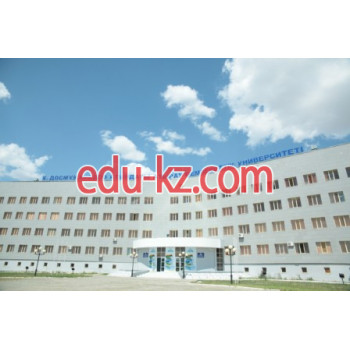Dosmukhamedov Atyrau state University
Dosmukhamedov Atyrau state University
The need to open a higher education institution in Guriev appeared on the eve of the second world war, as there was an acute shortage of specialists in the region. At that time, there was only one school in the city that trained primary school teachers. Thus, in 1939, an educational institution was opened that trained teachers of all profiles, with a training period of two years. The first year of study at the Institute was 120 people, and based on the number of students, a year later a hostel was opened, and in 41 a new hostel for 500 people was found. In the post-war period, there were absolutely not enough teachers, so in 1950 the Guryev teachers ' Institute was opened, teaching in three areas: physics and mathematics, Philology and natural geography. The physics and mathematics Department was located in the building of the teachers ' Institute, and the Philology Department was located in school No. 6.
The building of the former Lenin school and two barracks for students ' accommodation became the academic building of the University. The first graduation of new teachers was 150 in 1952. Years passed, the material and technical base of the College improved, new teachers appeared. However, there was a demand for specialists of this profile, which the new Institute did not train. In 1959-1960, two more departments were created and correspondence courses were opened.
The year 1963 was marked by the University receiving a boarding school building, where students of the faculty of history and Philology and the administration of the higher educational institution itself moved to study. The University expanded and by 1970 had 15 faculties. In order to provide better education, teachers from abroad began to be attracted for the first time in 1975. In the same year, the number of teachers increased to 120 people, of which 17 people had academic degrees, and 30 only completed postgraduate studies, there were already 2700 students.
Since 1962, scientific conferences have been held, and the Department of advanced training has been functioning. Much attention was paid to staffing the library, which already had a book collection of 130,000 copies. For educational purposes, the library had a cinema hall where pre-war and post-war films were shown. Much attention was paid to leisure and student organizations. They began to hold KVN, there were sewing, guitar, debate, cooking clubs. The first aid circle was very popular. More than a quarter of all students were involved in student leisure. Music teachers organized a vocal choir, wind choir, and orchestras of Russian and Kazakh instruments.
In 1977, at the previously opened faculties of "Music and singing" and "Pedagogy of primary education", the faculty of music and education was opened. The process of re-profiling teachers has begun, new departments of theoretical physics, mathematical analysis, geometry, pioneer and Komsomol work have appeared. Thus, by 1980, the number of departments increased to 24.
In December 1986, the University opened a student canteen with 220 seats. Later, a sports complex was opened, including a sports field, a gym and a large swimming pool. In 1988, a third 400-bed dormitory was built and put into operation. A new building of the educational institution was completed, which could accommodate another 1200 people. In 1990, the first language laboratory was opened, where teachers of foreign language and literature were trained. The total number of students was 4,776.
The year 2000 was the year when the educational institution received its third building and fourth dormitory. The potential of the teaching corps has increased, numbering 390 people, 107 of them have degrees and titles, 83 candidates and several professors. There were laboratories equipped with computers. Such laboratories helped to speed up the learning process of the entire University. The University began to carry out various off-site conferences, it established its own printing press, producing the University newspaper. Soon the first scientific works of teachers appeared, which were also implemented by our printing house.
Today, the University named after Halel Dosmukhamedov is a highly qualified teaching staff that includes: doctors of science and candidates of science, masters, academicians of international academies, excellent students of national education, journalists of the Republic of Kazakhstan, artists and masters of sports.
Today we have a program of the European Union aimed at helping projects created by our talented youth. It has its own Museum, founded in 2001. Currently, the University teaches 46 bachelor's and 14 master's degrees. The educational space includes 5 educational buildings, 2 large dormitories, a sports complex "Zhaiyk" and a medical center. 500 teachers teach more than 6 thousand students annually. There are six faculties: "Innovative technologies"," Natural and agricultural Sciences"," Physics, mathematics and information technologies"," Humanities and foreign languages"," Faculty of Economics and law","faculty of multilingual education".
The Museum contains elements indicating the development and formation of the history of the institution, including links and materials indicating the founder of the Institute. There you can see halls on the stages of development of the University including "Guryev Institute of teachers", "Guryev pedagogical Institute", "Atyrau pedagogical Institute", " Atyrau pedagogical Institute named after H. Dosmukhamedov", " Atyrau state pedagogical University named after Kh. Dosmukhamedov", a Chronicle of rectors of our University, honorary teachers, doctors of science, our graduates, as well as the culture and traditions of the University.


